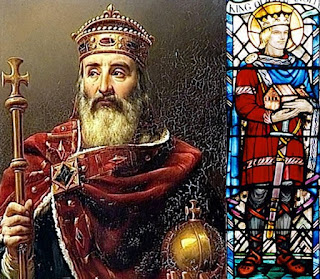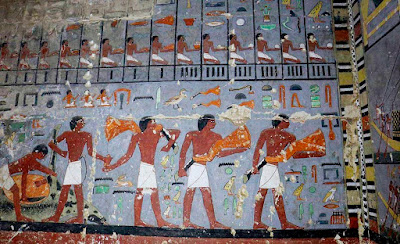 |   |  |
Tuesday, April 30, 2019
Sunday, April 28, 2019
King Offa of Mercia
Sunday, April 21, 2019
Ancient ‘Texas Serengeti’ had rhinos, alligators, 12 kinds of horses
 | From 1939 to 1941 a federal agency that provided work to millions of Americans during the Great Depression put unemployed Texans to work as fossil-hunters. They dug up tens of thousands of specimens from sites near Beeville, Texas. For the past 80 years the fossils have been stored at the University of Texas at Austin and virtually forgotten. |  |
 | The fossil trove of nearly 4,000 specimens represent 50 animal species, all of which roamed the Texas Gulf Coast around 12 million years ago. Among the finds was a new genus of gomphothere, an extinct relative of elephants with a shovel-like lower jaw. |  Other fossils include the American alligator and an extinct relative of modern dogs. |
Saturday, April 20, 2019
Metal Detectorists in U.K. land huge 14th century hoard
 | The full gold nobles might be worth up to £10,000 each although condition may be an issue. The silver coins might be worth between £20 and £50.  |  |
Friday, April 19, 2019
Rare Byzantine gold coin found by schoolboys in Israel
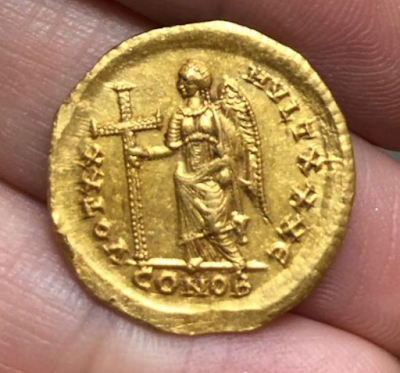 | A rare Byzantine gold coin has been found by a group of schoolboys in northern Israel. The coin was found along a stream in the Galilee region. The coin is a solidus minted by the emperor Theodosius II in Constantinople around 420–423 CE. Theodosius II was named to the throne as an infant in 402 and ruled until 450 when he died in a riding accident. A high quality (AU) Theodosius II solidus would expect to make at least $ 1500. | 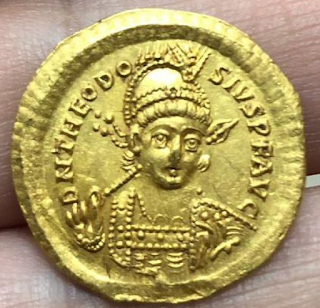 |
Tuesday, April 16, 2019
Ides of March - Pawn Stars
| The Ides of March was a day in the Roman calendar that corresponds to 15 March. It was marked by several religious observances and was notable for the Romans as a deadline for settling debts. The Ides is the 13th for most months, but the 15th in March, May, July, and October. In 44 BC, it became notorious as the date of the assassination of Julius Caesar which made the Ides of March a turning point in Roman history. |
Monday, April 15, 2019
Ancient Egyptian Tomb found with spectacular art
 | A recently discovered 4,300 year old tomb belonging to a high-ranking official is covered in colorful reliefs and well-preserved inscriptions. The tomb dates to the Fifth Dynasty, around 2400 BC. |  |
Friday, April 12, 2019
British woman accused of stealing ancient tiles from Pompeii
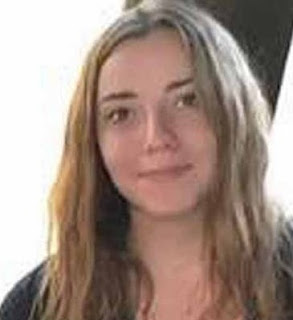 | Caprice Arnold, a 21-year-old from the UK, thought it would be great idea to loot tiles from Pompeii. She climbed over a barrier and used a sharp object to cut 20 tiles from a floor. A caretaker of the grounds spotted her. The guard stopped her and asked for her details to make a report, but she walked away, leaving the mosaic pieces on the ground. "The woman showed no remorse" said a statement. Back in the UK, she claims she only bent down to 'inspect loose tiles.' She cannot explain how 3 tiles ended up in her bag. "It ruined the trip from then on and I was not able to enjoy it" she said. |  |
 | Authorities spotted Arnold scaling the security rail at the House of the Anchor, one of the most famous homes at the ancient historical site. The house is known for the mosaic tile anchor design at the front of the residence. |  |
 | The damage is thought to be around $ 5,000. It is far from the first time Italian police has taken action on tourists vandalizing and looting the historic city. |  |
Thursday, April 11, 2019
Roman emperor Trajan statue revealed in Turkey
 | Archaeologists in the ancient city of Laodicea in the western province of Denizli have unearthed a grandiose statue of Trajan. Researchers think the Trajan statue—which once stood by a fountain—was destroyed and buried in an earthquake. The team pieced together all 356 fragments to reconstruct the imposing monument. The statue is likely unique in terms of its size and intricacy. The three-meter-high sculpture is highly detailed. The emperor's clothes feature symbols from Roman mythology: Jupiter’s thunderbolt, the head of Medusa and two griffins representing Apollo. Towards the end of the Roman Republic, Laodicea benefited from its advantageous position on a trade route, and became one of the most important cities of Asia Minor. Early Laodicea became a seat of Christianity. |  |
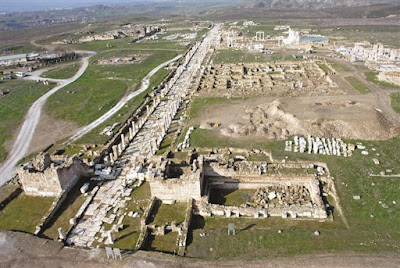 | The area is prone to earthquakes, and a great tremor occurred in the reign of Nero (60 AD) that completely destroyed the city. |  |
See ----->Trajan - optimus princeps
Wednesday, April 10, 2019
'Fast food' counter found in Pompeii
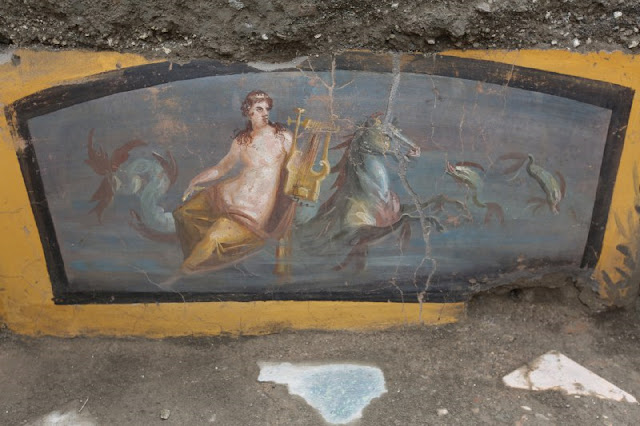 | Archaeologists have discovered a well-preserved “fast food” counter at Pompeii. The frescoed counter was found in one of 150 thermopolia, Roman cook-shops, which were discovered in the Regio V area of the city. In ancient Rome, fast food parlors served the poor who could not afford to install kitchens at their homes. Menus typically included coarse bread with salty fish, baked cheese, lentils, and mulled spiced wine. |
Subscribe to:
Posts (Atom)



